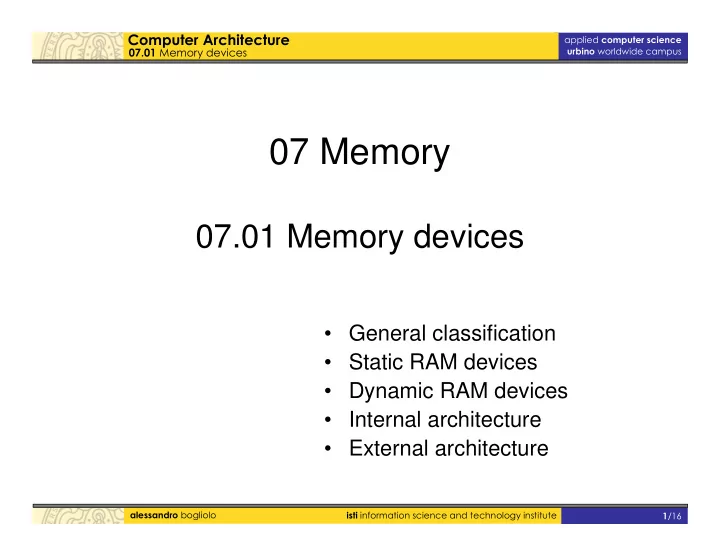

��������������������� �������� ���������������� ������ ���������������� ������ �������������� 07 Memory 07.01 Memory devices • General classification • Static RAM devices • Dynamic RAM devices • Internal architecture • External architecture ���������� �������� ���� �������������������������������������������� � ���
��������������������� �������� ���������������� ������ ���������������� ������ �������������� Classification • First classification criterion: volatility – Volatile memories: Loose data when there is no power supply – Non-volatile memories: Retain data even without power supply • Second classification criterion: read-write balance – ROM: read-only memories – PROM: programmable ROM – EPROM: erasable PROM – EEPROM: electrically-erasable PROM – FLASH: read-most non-volatile memories – RAM: volatile read-write random-access memories ���������� �������� ���� �������������������������������������������� � ���
��������������������� �������� ���������������� ������ ���������������� ������ �������������� Static RAM (SRAM) cell If x=0, the lower inverter provides y=1, that in its turn causes the upper inverter to sustain x=0 If x=1, the lower inverter provides y=0, that in its turn causes the upper inverter to sustain x=1 • The bistable can be used to store a bit • The stored bit is represented by the state of the internal node x • In order to use a bistable as a memory element we need a mechanism to – write a bit, i.e., change the value of x according to the bit to be stored – read a bit , i.e., bring the value of x outside the cell ���������� �������� ���� �������������������������������������������� � ���
��������������������� �������� ���������������� ������ ���������������� ������ �������������� Static RAM (SRAM) external connections • To make internal nodes accessible from outside the cell, two switches (i.e., transistors) are used that connect nodes x and y to two external lines, called BL ( bit line ) and BL’ • Switches are controlled by a signal called WL ( word line ) ���������� �������� ���� �������������������������������������������� � ���
��������������������� �������� ���������������� ������ ���������������� ������ �������������� Static RAM (SRAM) read • To read the content of the cell, the bit lines BL and BL’ are kept floating while asserting WL • The pull-up and pull-down transistors of the internal inverters drive the bit lines bringing them to the nomial values of x and y • The device is called static since the value of the bit is associated with the steady state of a bistable • The pull-up and pull-down circuits drive the bit lines to 1 (0) by statically connecting them to power supply (ground) ���������� �������� ���� �������������������������������������������� � ���
��������������������� �������� ���������������� ������ ���������������� ������ �������������� Static RAM (SRAM) write • To write a bit (say b) in the cell, the bit lines BL and BL’ are driven by external drivers that provide static paths to Vdd and Ground according to the taregt values of b and b’ • The WL is asserted when the bit lines are externally driven • If the value of b is not equal to the previous value of x, the write operation causes an electrical conflict between the external drivers and the internal inverters • If Rc and Rb are the resistances of the paths provided by the cell and by the bit line to Vdd and Ground, the final value of x is determined by the path with the lower resistance • Write operations require Rb << Rc ���������� �������� ���� �������������������������������������������� � ���
��������������������� �������� ���������������� ������ ���������������� ������ �������������� Dynamic RAM (DRAM) cell • The dynamic RAM cell is a simple capacitor, that is a passive 2- terminal component that exhibits a voltage difference (between the two terminals) proportional to the amount of charge stored Q = VC C is the capacitance of the capacitor. • If one of the two terminals is connected to ground, V is the voltage level at the other one, that we denote by x • A capacitor can be viewed as a cylindrical reservoir having section C. In this case, the stored charge (Q) is the volume of the fluid contained in the reservoir and x (or V) is its level. • A transistor driven by the word line (WL) can be used in a memory device to connect the cell to the bit line (BL) ���������� �������� ���� �������������������������������������������� � ���
��������������������� �������� ���������������� ������ ���������������� ������ �������������� Dynamic RAM (DRAM) refresh • An ideal isolated capacitor can store its charge forever. • Actual circuits are not ideal: both capacitors and transistors are leaky devices • DRAM cells loose their charge, thus impairing the retention of the stored data • In order not to loose data, the content of a DRAM cell need to be periodically refreshed • Refreshing the content of a DRAM cell entails reading its value and writing it back ���������� �������� ���� �������������������������������������������� � ���
��������������������� �������� ���������������� ������ ���������������� ������ �������������� Dynamic RAM (DRAM) write • To write a bit (say b) in the cell, the bit line BL is driven to the target value of b while asserting WL • When the capacitor is connected to a driven line, it is charged or discharged in order to reach the voltage level of the driven line • The connection of a capacitor C to power supply (ground) can be viewed as the connection of a section-C reservoir to a second reserevoir with infinite section filled of fluid up to level Vdd (or 0). ���������� �������� ���� �������������������������������������������� � ���
��������������������� �������� ���������������� ������ ���������������� ������ �������������� Dynamic RAM (DRAM) read • To read the bit stored in the cell, the cell is connected to a floating bit line. • Notice that the bit line has its own parasitic capacitance Cb, that is usually much larger than C • When the connection is extablished, the charge Q stored in the cell (C) redistributes between C and Cb • If Cb was originally empty, and the value stored in the cell was 1, the result of the charge redistribution process is a voltage level that is below the logic threshold Vdd/2, and is not recognized as a logic 1 ���������� �������� ���� �������������������������������������������� �� ���
Recommend
More recommend